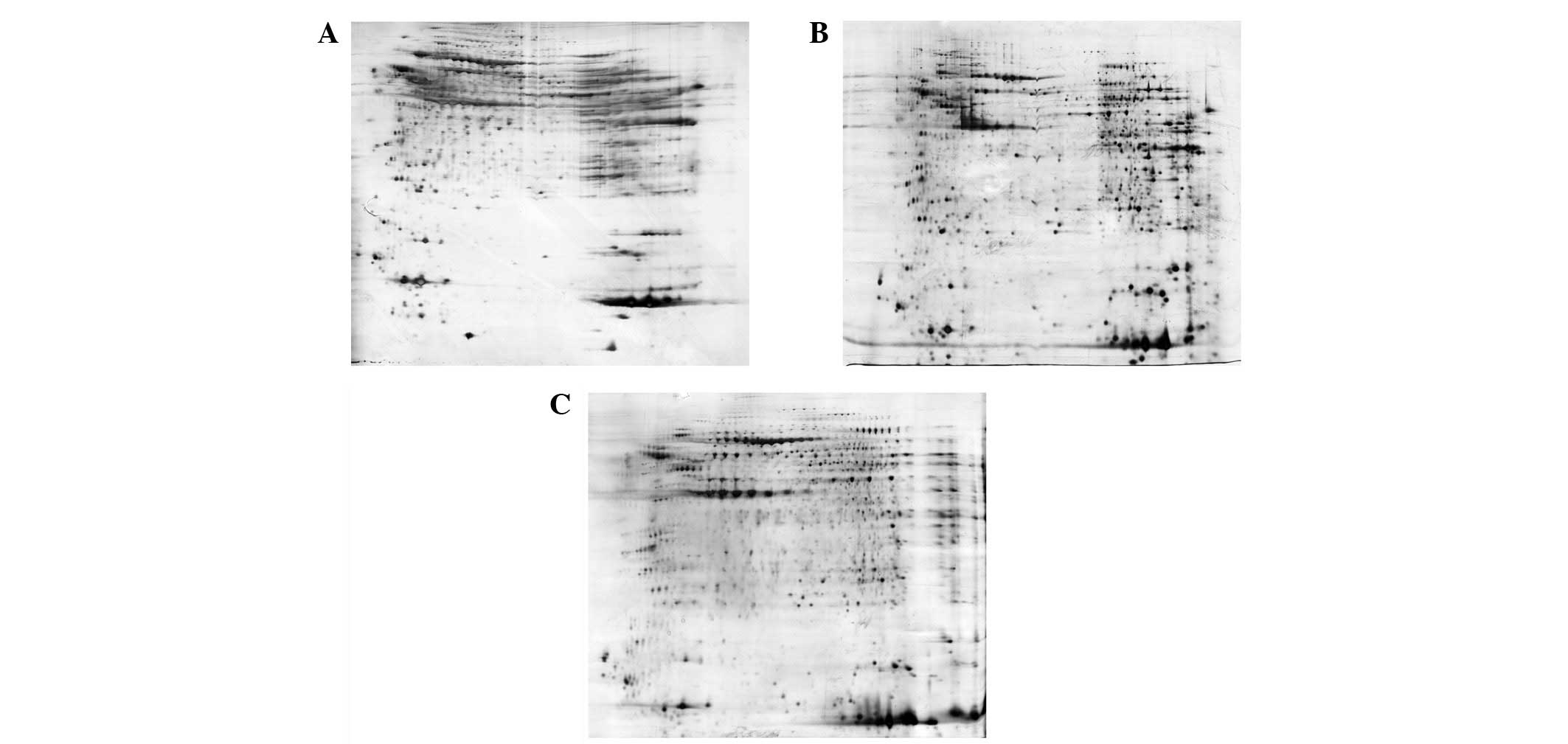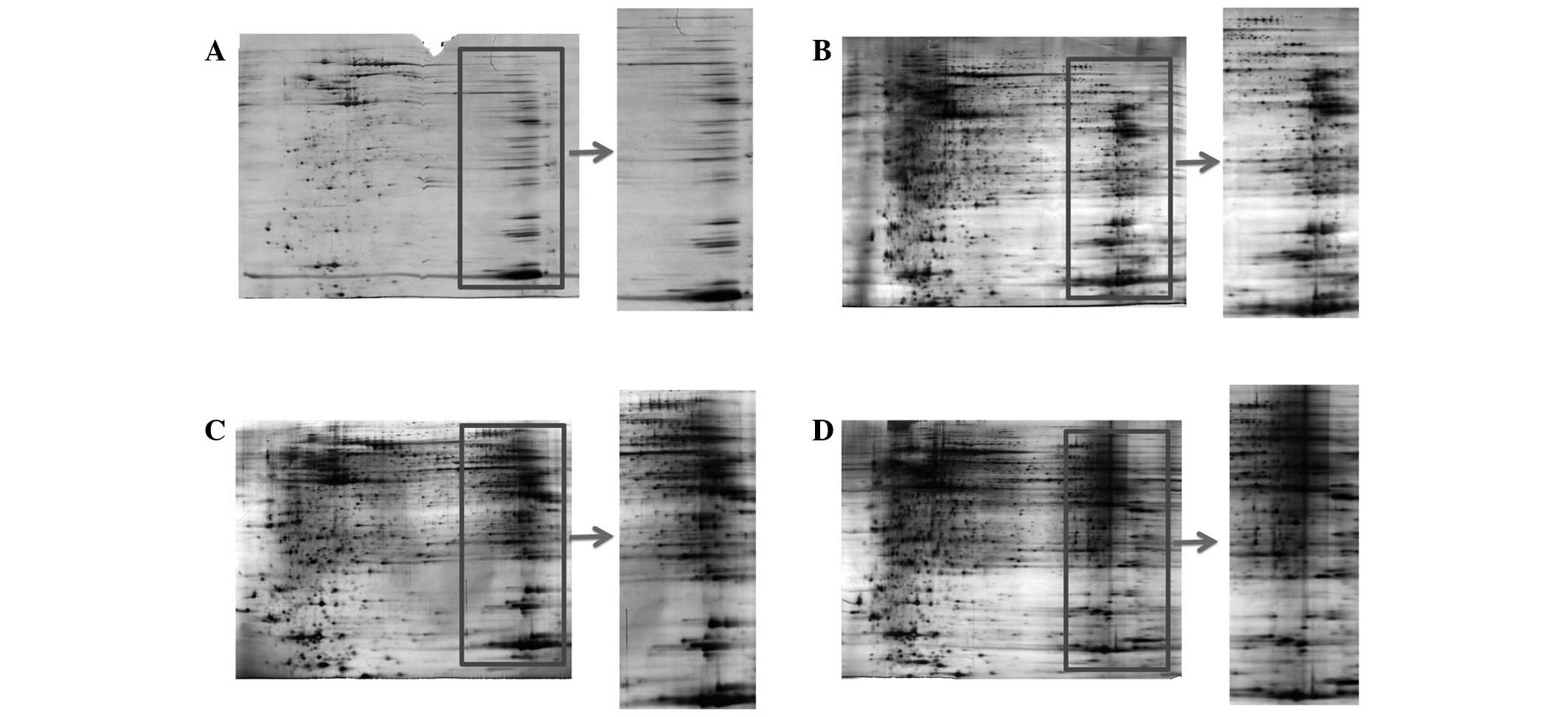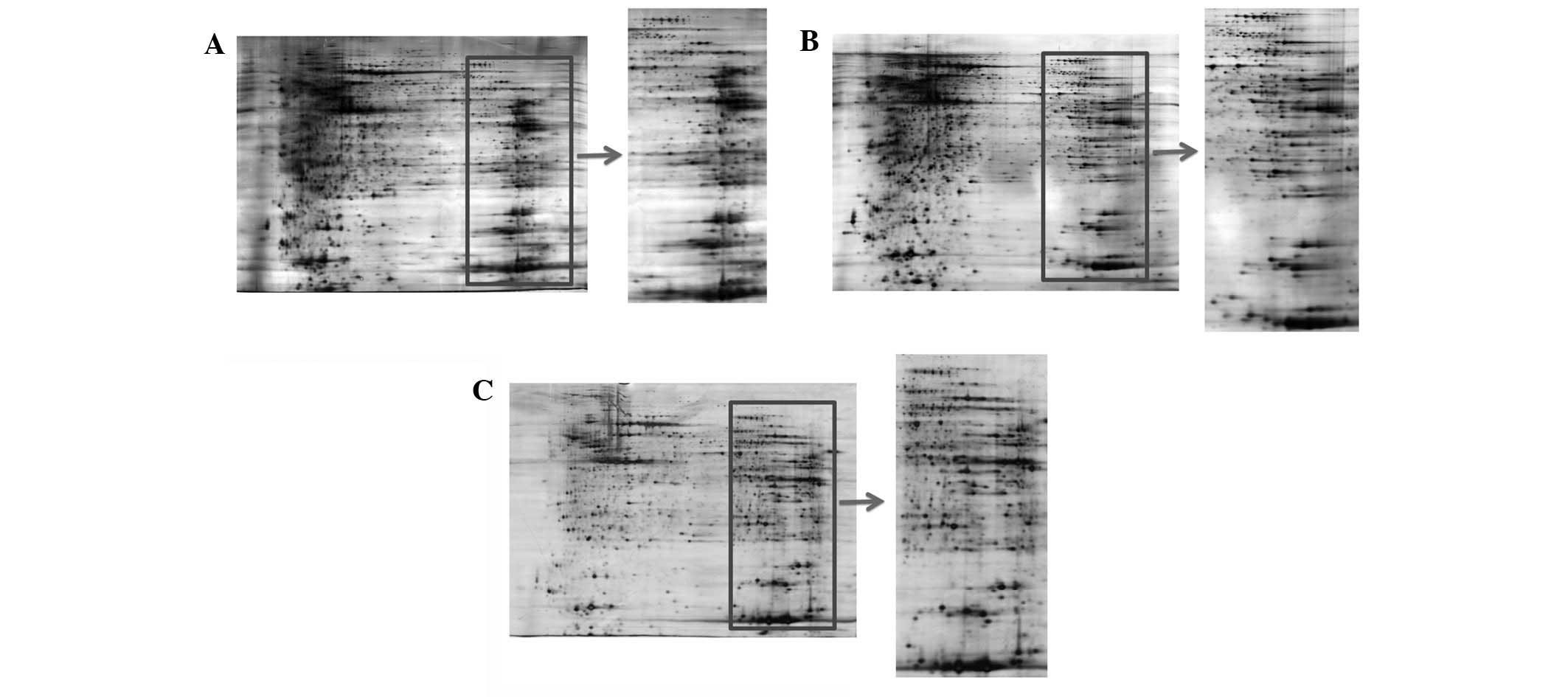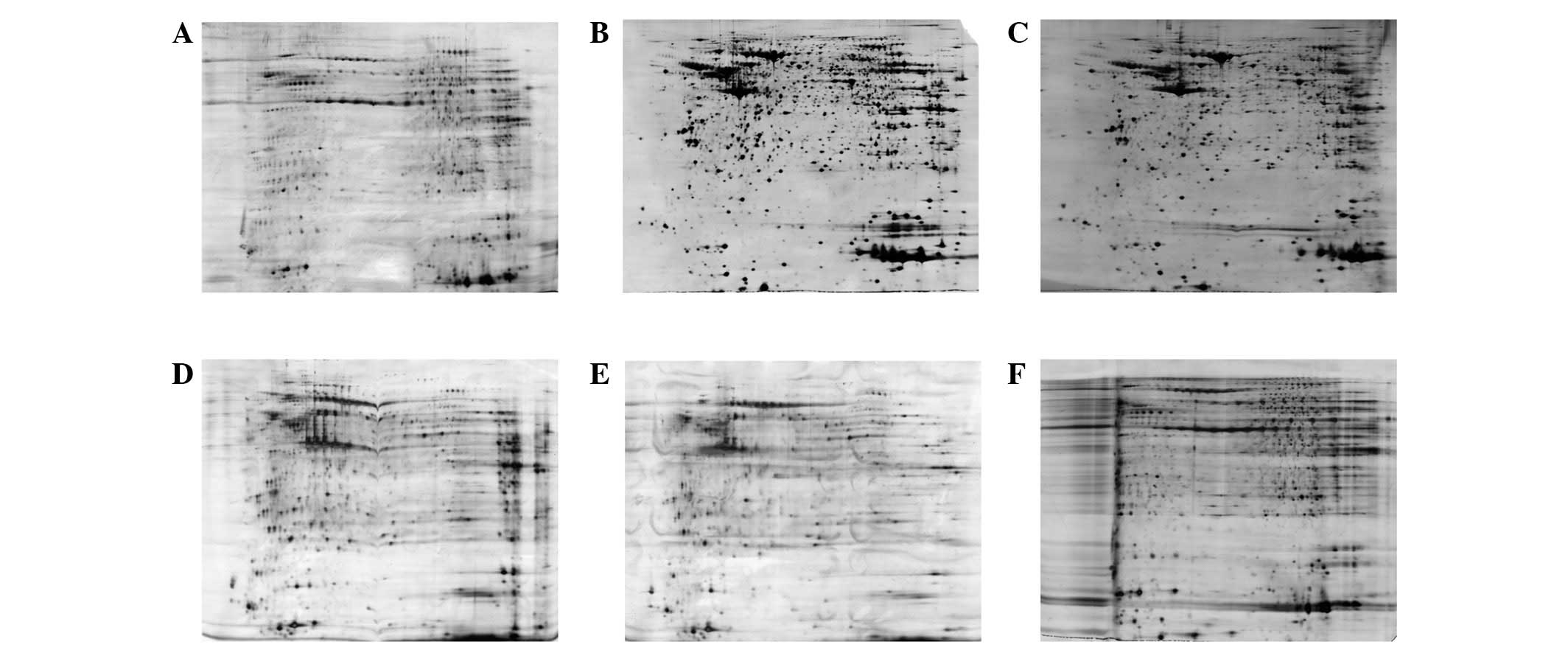Optimization of 2-dimensional gel electrophoresis for proteomic studies of solid tumor tissue samples
- Authors:
- Published online on: November 20, 2013 https://doi.org/10.3892/mmr.2013.1815
- Pages: 626-632
Abstract
Introduction
Two-dimensional gel electrophoresis (2-DE), a technical tool possessing the ability to separate complex protein mixtures with high resolution, has been widely employed for protein profiling studies since the mid-1970s (1,2). It is also the major method used in comparative proteomic studies to screen biomarkers and identify molecular targets of drug actions, as it enables differentially expressed proteins between different groups to be readily visualized. However, optimization studies of the 2-DE method have not yet been conducted, particularly regarding the analytical conditions and procedures of protein extraction, duration of isoelectric focusing (IEF) and reduction and alkylation reaction.
The 2-DE experiment was divided into three major steps: The extraction of proteins from tissues or cells; first-dimension (1D) separation based on protein isoelectric points (pI) using IEF; and the second-dimension (2D) separation based on protein molecular weight using sodium dodecyl sulfate-polyacrylamide gel electrophoresis (SDS-PAGE) (3). Of these, protein extraction and 1D separation are the most crucial steps for optimizing 2-DE analysis. During protein extraction, a number of proteins may be non-specifically lost or degraded, leading to variability of results in 2-DE analysis. In 1D separation, immobilized pH gradient (IPG) strips with different lengths are used according to the specific purposes of the study. For instance, the shorter strips (7, 11 and 13 cm) usually result in faster and cost-effective screening, but the protein loading capacity is limited and the quantitation and identification of particular spots may be compromised due to spot overlapping (4). The longer strips (17, 18 and 24 cm), which are designed for maximizing resolution and loading capacity, allow the improved detection of spots and easier selection and identification of the proteins in the map. In addition, the alkylation of amino acid residues by cross-linkers during IEF processes may be non-specifically induced (5). Therefore, conditions in these procedures require optimization.
In the 2-D gel analysis of tumor tissue samples, it is particularly difficult to achieve acceptable resolution using the existing 2-DE protocols due to the multicellularity of tumor tissues. To date, 2-D gel methods performed on tumor tissue proteomes have been, generally, based on the existing procedures. In the present study, the key steps of sample preparation, reduction and alkylation, and the 1D separation process in 2-DE analysis on 24-cm strips were optimized for the 2-DE images of proteins in mouse tumor tissue samples. The optimized conditions provide a valuable tool for identifying novel biomarkers of diseases and the underlying molecular mechanisms and targets of drugs.
Materials and methods
Establishment of a lung cancer model in mice
The LLC-1 cells were obtained from the American Type Culture Collection (Rockville, MD, USA). Male C57BL/6J mice (n=12) at the age of 6–8 weeks were obtained from The Chinese University of Hong Kong (Hong Kong, China). Animal care and treatment procedures conformed to the Institutional Guidelines and Animal Ordinance (Department of Health, HKSAR). The LLC-1 cells harvested from in vitro culture were adjusted to a concentration of 1.5×107 cells/ml and 0.1 ml cell suspension was injected subcutaneously into the dorsal region of the male C57BL/6J mice. After 21 days, the mice were sacrificed and their tumor tissues were dissected and isolated for frozen storage at −80ºC. The animal experiment was approved by the ethics committee of Macau University of Science and Technology (Macau, China).
Protein extraction from tumor tissues
Tumor tissues (50 mg) were washed with distilled water three times and protein extraction was performed by one of the following four procedures. i) Bead mill-based protein extraction using a TissueLyser LT (Qiagen, Hilden, Germany): Proteins in the mouse tumor tissues were extracted using TissueLyser LT (Qiagen): Proteins in the mouse tumor tissues were extracted using TissueLyser for 2 min at 50 Hz with two metal beads with urea/thiourea lysis buffer [7 M urea, 2 M thiourea, 4% (w/v) CHAPS, 30 mM Tris/HCl, pH 9.0; 1:10 w/v] and urea lysis buffer [8 M urea, 4 % (w/v) CHAPS, 30 mM Tris/HCl, pH 9.0; 1:10 w/v], respectively. ii) Homogenization-assisted protein extraction: The tumor tissues were cut into fine pieces and homogenized with urea/thiourea lysis buffer (1:10 w/v). iii) Sonication-assisted protein extraction: The tumor tissues were sonicated (10 strokes, low amplitude) with urea/thiourea lysis buffer (1:10 w/v) on ice. iv) Grinding-assisted protein extraction: The frozen tumor tissues were ground to a fine powder under liquid nitrogen and then immediately suspended in urea/thiourea lysis buffer (1:10 w/v).
The lysates obtained by each of the four techniques were incubated on ice for 5 min and centrifuged at 17,000 × g at 4ºC for 1 h. The supernatants were collected and 200 μl of the extracts was precipitated with a 2-D Clean Up kit (GE Healthcare, Chalfont St. Giles, UK) according to the manufacturer’s instructions, or with ice-cold acetone. The pellets were resuspended in urea/thiourea lysis buffer and the protein concentration was determined using a 2-D Quant kit (GE Healthcare). The protein concentration was adjusted to 5 μg/μl.
2-DE
Rehydration
For rehydration, the existing procedure (3) and the modified methods of the present study were used as below.
The existing procedures (3)The protein sample was made up to 5 μg/μl in 450 μl with rehydration buffer [8 M urea, 2% (w/v) CHAPS, 0.5% (v/v) of pH 3.0–10.0 NL IPG buffer (GE Healthcare)] containing 1% or 2% DTT. Additionally, an extra paper soaked with 1% DTT was placed near the cathode during 1D IEF. The mixtures were applied to Immobiline DryStrip gels (IPG strips; pH 3–10 NL, 24 cm; GE Healthcare) by in-gel rehydration for 16 h at room temperature in an immobiline DryStrip Reswelling Tray (GE Healthcare).
Modified methodsReduction and alkylation of proteins was performed prior to IEF. The protein samples (5 μg/μl) was pre-reduced and alkylated by one of the six methods shown in Table I. The mixtures were made up to 450 μl with rehydration buffer and applied to the IPG strips using the same procedure as previously described.
1D IEF
The IPG strips were transferred to an Ettan IPGphor II Manifold (GE Healthcare). IEF was initiated at a low voltage (200 V, 1 h; step-n-hold, 500 V, 1 h; step-n-hold, 1,000 V, 1 h; step-n-hold), and then raised to 10,000 V for 6 h, with the current limited to a maximum of 75 μA/strip throughout the procedure. The strips were focused for 40,000, 50,000, 70,000 and 80,000 Vhr, respectively.
2D SDS-PAGE
The focusing IPG strips were immediately equilibrated in SDS equilibration buffer [6 M urea, 75 mM Tris-HCl (pH 8.8), 30% glycerol (v/v), 2% SDS (w/v), 0.002% (w/v) bromophenol blue] containing 10 mg/ml DTT for 15 min, and thereafter in the SDS equilibration buffer containing 25 mg/ml IAA for 15 min. Following equilibration, proteins were separated by 12.5% SDS-PAGE, which was run until the bromophenol blue dye reached the end of the gel.
Image analysis
Following 2-DE separation, the gels were fixed for >30 min in 40% ethanol and 10% acetic acid, and stained using a PlusOne Silver Staining kit (GE Healthcare). The stained gels were then scanned with an Image Scanner III (GE Healthcare) and images of the spots were automatically analyzed using ImageMaster 2D Elite software (GE Healthcare).
Protein identification by MALDI-TOF/TOF
The protein spots of interest were excised from the silver-stained gels and subjected to trypsin digestion, according to the methods of Shevchenko et al (6). The digested peptides were extracted from the excised gel pieces and analyzed using an autoflex™ speed MALDI-TOF/TOF system (Bruker Daltonics, Bremen Germany).
For the acquisition of mass spectra, a thin layer of matrix (40 mg/ml α-cyano-4-hydroxycinnamic acid in 98% acetone) was deposited on an MTP AnchorChip™ 384 MALDI target (800 μm diameter; Bruker Daltonics). One microliter of the extracted peptides was spotted onto a thin layer of the matrix solution on the target plate and allowed to air dry. MALDI TOF/TOF MS data were acquired using FlexControl 2.4 (Bruker Daltonics) and analyzed using FlexAnalysis 2.4 (Bruker Daltonics). The generated peak list was searched against the SwissProt Mus musculus protein database (SwissProt 57.1; 462,764 sequences, 163,773,385 residues) using in-house MASCOT Server software, version 2.3 (Matrix Science, London, UK) with the following parameters: cysteine carbaminomethylation and methionine oxidation as fixed modification and variable modification, respectively; precursor mass tolerance, 50 ppm; MS/MS mass tolerance, 0.5 Da; and a maximum of one missed cleavage was allowed. Proteins were only identified when the ion score was above the sequence identity threshold.
Results
Optimization of the protein extraction methods
The quality of 2-DE analysis largely depends on the quality of sample preparation during protein extraction. Unnecessary procedures should be avoided to increase the reproducibility and minimize modifications that may result in artifactual spots on 2D gels. The present study compared four protein extraction methods in terms of protein yield and processing time (Table II). In general, protein extraction by grinding in liquid nitrogen, sonication or homogenization was highly time-consuming, with a low throughput and low protein yield. Extraction using a TissueLyser yielded the highest amount of protein within a minimal processing time. In addition, 12 samples were processed simultaneously. Therefore, this optimized method was adapted for the subsequent 2-DE analysis.
Table IIComparison of protein yield and processing time for four protein extraction conditions with urea/thiourea lysis buffer. |
Clean-up of protein samples
Following protein extraction, contaminants such as salts, lipids, nucleic acids and detergents must be removed to prevent horizontal streaking during IEF. Proteolytic enzymes must also be inhibited to prevent non-specific protein degradation (7). The present study used a 2-D Clean-Up kit and acetone precipitation for contaminant removal (Fig. 1). Prior to sample clean-up, 1,478 protein spots were detected and extensive horizontal streaking was clearly observed (Fig. 1A). Following purification with the 2-D Clean-Up kit, 2,000 protein spots were detected and the horizontal streaking was markedly reduced. The gel image also provided higher resolution when compared with the raw sample (Fig. 1B). On the other hand, acetone precipitation minimizes protein degradation by denaturing most of the proteolytic enzymes and removes contaminants contained in the tissue samples. However, the incomplete precipitation and resolubilization of proteins results in non-specific loss of proteins (3). As such, only 1,657 protein spots were detected and the resolution was decreased by using ice-cold acetone precipitation in the present study (Fig. 1C). Therefore, the 2-D Clean-Up kit was used in the subsequent 2-DE analysis, which may achieve 20% more protein spots.
Influences of the buffer used for solubilization of proteins
The buffer used for the extraction and solubilization of proteins in the tested samples also influenced the quality and reproducibility of the 2-D gel images. Urea lysis buffer has been reported to be insufficient for solubilizing highly hydrophobic proteins, including membrane proteins (8). By contrast, the addition of thiourea to the lysis buffer improves the solubilization of proteins (8). As shown in Fig. 2, using urea/thiourea lysis buffer in the sample preparation allowed more protein spots to be identified and provided higher gel resolution than when using urea lysis buffer. When using urea lysis buffer, 2,000 protein spots were detected (Fig. 2A), while 2,500 protein spots were detected when urea/thiourea lysis buffer was used (Fig. 2B). Therefore, urea/thiourea lysis buffer was used in the subsequent analysis, which may achieve 20% more protein spots.
Optimization of the conditions during electrophoresis
In the IEF procedures of electrophoresis, the focusing time and pre-reduction processes are the pivotal factors in protein separation and detection by 2-D gel analysis.
Focusing time
The focusing time strongly affects the attainment of steady-state IEF patterns. It is also an essential factor in achieving high quality and reproducible 2-D gel images. Insufficient focusing induces horizontal and vertical streaking, while overfocusing may result in distorted protein patterns and horizontal streaking at the basic gel end, leading to loss of protein spots (9,10). In the present study, different focusing times were compared (Fig. 3). When the sample was focused for 40,000 Vhr, incomplete focusing and heavy horizontal streaking were observed in the 2-D gel image (Fig. 3A), indicating that the focusing duration is insufficient for most of the proteins to achieve steady-state focusing. When the samples were focused for 60,000 and 70.000 Vhr, the image quality around neutral pH was acceptable but heavy horizontal streaking was observed in the areas near the cathode electrodes (Fig. 3C and D), indicating overfocusing. By using 50,000 Vhr, optimal gel resolution and minimized streaking were observed (Fig. 3B). Collectively, the results indicated that 50,000 Vhr was optimal for the 2-D gel protein analysis of tumor tissue samples.
Reduction and alkylation of unexpected proteins prior to IEF
The reduction process is another pivotal factor in protein separation and detection by 2-D gel analysis. DTT is a strong reducing agent, which is often adopted for breaking disulfide bonds and unfolding protein secondary and tertiary structures. Depletion of DTT during IEF may induce horizontal streaking due to protein re-oxidation, which is particularly common in large gels (3). To achieve a well-focused 1D separation, protein extracts in rehydration buffer and 1 or 2% DTT were compared. Increasing the percentage of DTT in the rehydration buffer reduced the horizontal streaking and improved gel resolution at the cathode, although it also resulted in distorted protein patterns (Fig. 4A and B). In addition, a study has demonstrated that a shortage of the reducing agent is avoidable by placing an extra paper soaked with DTT near the cathode (11). Nevertheless, each of these two methods alone was insufficient in diminishing horizontal streaking, while improved resolution and inhibition of re-oxidation of the sulfhydryl groups, produced by the dynamic loss of DTT, was achieved with 1% DTT when an extra paper soaked with 1% DTT was used near the cathode (Fig. 4C).
A previous study demonstrated that the reduction and alkylation of proteins prior to IEF greatly reduces the streaking caused by IEF (12). Following reduction of the disulfide bonds by DTT, IAA was used to alkylate the free thiol groups of cysteine residues to prevent their re-oxidation (back reaction) during electrophoresis. The excess IAA was neutralized by adding an equimolar amount of DTT to prevent overalkylation. However, the protocol for pre-reduction and alkylation has varied greatly in different studies and the experimental conditions have not yet been clearly optimized (12,13). Thus, all factors, in terms of the time and temperature of the reaction, as well as the ratio of DTT/IAA, that may influence 2-D gel analysis were systematically examined in the present study (Table I). The results indicate that reduction and alkylation with DTT/IAA/DTT (10mM/40 mM/40 mM to 5 μg/μl protein) on ice for 1 h for each step prior to IEF achieves higher resolution and improved protein separation (Fig. 5).
Protein detection using two electrophoresis conditions
To investigate whether reduction and alkylation prior to IEF affect the final protein identification, matched protein spots from gels prepared with or without pre-reduction and alkylation were subjected to gel-based protein identification. A total of 13 matched spots were excised from different areas of the 2-D gels for analysis (Fig. 6). Only eight spots (numbers 2, 3, 5, 6, 7, 8, 9 and 13) from the existing procedure were successfully identified, while all spots were identifiable following pre-reduction and alkylation (Table III). It was not possible to identify confidently spot numbers 1, 4, 10, 11 and 12 from the existing procedure as multiple overlapping peptides were recovered due to horizontal streaking. The results indicate that the modified conditions of the present study are more effective for finding biomarkers and molecular targets.
Discussion
Overall, the present study has optimized the sample preparation and 1D separation conditions for the 2-DE analysis of tumor tissue samples. Compared with the previously reported conditions, the present study demonstrated that tumor tissue proteins extracted by a bead mill TissueLyser LT with urea/thiourea lysis buffer, followed by 2-D Clean-Up kit purification produced optimal throughput and protein yielding rates. In addition, the reduction and alkylation of proteins with optimal focusing conditions prior to IEF on a 24-cm strip was demonstrated to be effective in preventing the horizontal streaking caused by oxidation and in identifying biomarkers and molecular targets. In conclusion, the modified conditions and protocols of the present study allowed the 2-DE analysis of tumor tissue proteins with enhanced reproducibility and sensitivity and higher 2-DE protein recovery and resolution.
Acknowledgements
This study was supported by the Science and Technology Development Fund, MSAR (Project code: 035/2011/A2).
References
|
Klose J: Protein mapping by combined isoelectric focusing and electrophoresis of mouse tissues. A novel approach to testing for induced point mutations in mammals. Humangenetik. 26:231–243. 1975. | |
|
O’Farrell PH: High resolution two-dimensional electrophoresis of proteins. J Biol Chem. 250:4007–4021. 1975. | |
|
Görg A, Obermaier C, Boguth G, et al: The current state of two-dimensional electrophoresis with immobilized pH gradients. Electrophoresis. 21:1037–1053. 2000. | |
|
Campostrini N, Areces LB, Rappsilber J, et al: Spot overlapping in two-dimensional maps: a serious problem ignored for much too long. Proteomics. 5:2385–2395. 2005. View Article : Google Scholar : PubMed/NCBI | |
|
Galvani M, Hamdan M and Righetti PG: Investigating the reaction of a number of gel electrophoresis cross-linkers with beta-lactoglobulin by matrix assisted laser desorption/ionization-mass spectrometry. Electrophoresis. 21:3684–3692. 2000. View Article : Google Scholar | |
|
Shevchenko A, Tomas H, Havlis J, Olsen JV and Mann M: In-gel digestion for mass spectrometric characterization of proteins and proteomes. Nat Protoc. 1:2856–2860. 2006. View Article : Google Scholar : PubMed/NCBI | |
|
Herbert B, Righetti P, Citterio A and Boschetti E: Sample preparation and prefractionation techniques for electrophoresis-based proteomics. Proteome Research: Concepts, Technology and Application. Wilkins MR, Appel RD, Williams KL and Hochstrasser DF: 2nd edition. Springer; Heidelberg Berlin: pp. 15–40. 2007, View Article : Google Scholar | |
|
Rabilloud T: Solubilization of proteins in 2-D electrophoresis. An outline. Methods Mol Biol. 112:9–19. 1999.PubMed/NCBI | |
|
Görg A, Postel W and Günther S: The current state of two-dimensional electrophoresis with immobilized pH gradients. Electrophoresis. 9:531–546. 1988. | |
|
Görg A: Two-dimensional electrophoresis. Nature. 349:545–546. 1991. | |
|
Görg A, Boguth G, Obermaier C, Posch A and Weiss W: Two-dimensional polyacrylamide gel electrophoresis with immobilized pH gradients in the first dimension (IPG-Dalt): the state of the art and the controversy of vertical versus horizontal systems. Electrophoresis. 16:1079–1086. 1995.PubMed/NCBI | |
|
Herbert B, Galvani M, Hamdan M, et al: Reduction and alkylation of proteins in preparation of two-dimensional map analysis: why, when, and how? Electrophoresis. 22:2046–2057. 2001. View Article : Google Scholar : PubMed/NCBI | |
|
Candiano G, Bruschi M, Musante L, et al: Blue silver: a very sensitive colloidal Coomassie G-250 staining for proteome analysis. Electrophoresis. 25:1327–1333. 2004. View Article : Google Scholar : PubMed/NCBI |















